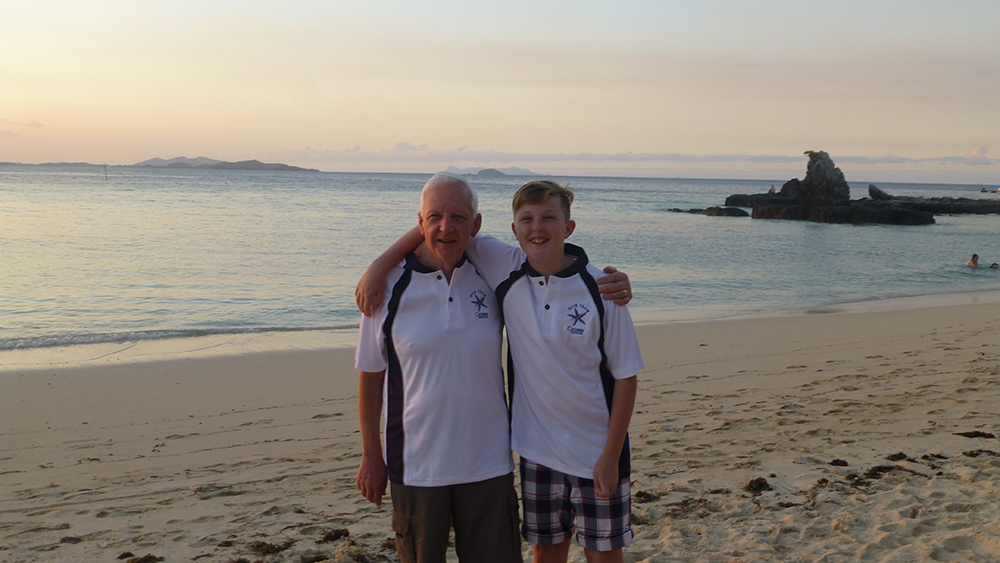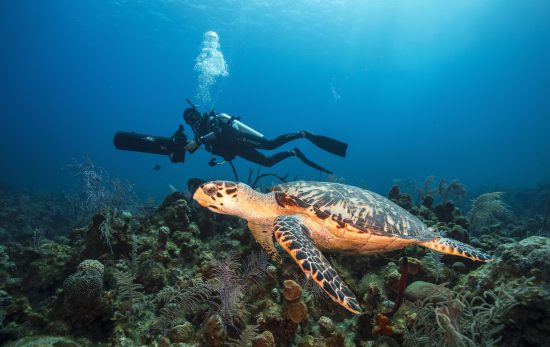When you tell someone you’re a scuba diver, you’re likely to get one of two reactions. If the person you tell is also a diver, you’ll have instant camaraderie and maybe a new dive buddy. If the person isn’t a diver, you may get an earful about bloodthirsty sharks and disbelief that you can dive anywhere – not just tropical destinations. To help counteract some of the incorrect information and outdated ideas circulating out there, we put together a list of the most common scuba diving myths.
Hopefully you’ll discover (like so many others have) that becoming a diver allows you to escape the pressures above the surface, to breath in, chill out, explore the beauty of the underwater world and #LiveUnfiltered.
Myth #1 You have to dive deep to see anything interesting
One of the first questions non-divers ask scuba divers is, “How deep can you dive?” Though some divers love the challenge of deep exploration, the vast majority of divers stay within 18 meters/60 feet where the water is warmer, colors are brighter and your air lasts longer.
Myth #2 The only good diving is in the tropics
You can dive just about anywhere there’s water, including inland areas such as lakes, quarries, decommissioned mines, and even missile silos. Some of the world’s best diving is found in cold water environments, such as British Columbia, Canada, South Africa, and The United Kingdom.
Myth #3 Scuba diving is dangerous
Snowboarding, cycling, running, even cooking can be dangerous if you’re careless. Scuba diving, like any activity, has specific do’s and don’ts that you learn during your PADI® Open Water Diver certification course.
The funny thing is, most non-divers think diving is dangerous because of sharks. The truth is there are at least 18 things more dangerous than sharks, including dogs, deer and cows.
Myth #4 Scuba diving is expensive
The cost to become a certified diver is similar to what you’d spend learning other outdoor activities. Tuition for an Open Water Diver course®, including 6-8 hours of pool practice and four dives with an instructor costs about the same as:
- a weekend of rock climbing lessons
- a weekend of kayaking lessons
- a weekend of fly-fishing lessons
- about three hours of private golf lessons
- about three hours of private water skiing lessons
- four private yoga lessons
Also, your PADI scuba certification is for life. You can level-up to new adventures with a PADI Instructor, but you’re also free to explore the ocean and #LiveUnfiltered with a buddy whenever you like. If you aren’t able to dive for a long time, PADI’s ReActivate® Scuba Refresher Program is a quick and easy way to restore any skills you may have forgotten.
Myth #5 You can only become a diver if you’re an excellent swimmer
As any beginner diver knows (or quickly realizes), vigorous swimming causes short dive times. Experienced divers are relaxed, rarely use their arms, and kick with long, slow strokes – basically the opposite of a competitive swimmer.
Basic water skills are all you need to become a scuba diver. This includes the ability to:
- Float or tread water for 10 minutes – you can lie on your back, on your front, tread water, “dog paddle,” or anything else to stay afloat without using any flotation aids.
- Swim 200 metres/yards (or 300 metres/yards in mask, fins and snorkel) without stopping. There is no time limit, and you may use any swimming strokes you want.
PADI Professionals can help people of nearly any ability become underwater explorers. Adaptive techniques allow individuals with physical challenges to scuba dive, and it’s not uncommon for people with paraplegia, amputations, or other challenges to earn a PADI Open Water Diver certification.
Myth #6 Scuba tanks are full of pure oxygen
The air we breathe is about 21 percent oxygen and 78 percent nitrogen, and that’s what’s inside most scuba tanks. Some recreational divers use a blend with extra oxygen, typically 31-36 percent, which is called enriched air nitrox.
If a diver is breathing pure oxygen, it’s probably due to an emergency situation. Learn more about becoming an Emergency Oxygen Provider.
Myth #7 You have to find someone to take the class with you
Diving with another person is safer and more fun than diving alone, but you can sign up for a scuba class without a partner. Many divers have lifelong friends who started out as a randomly-assigned dive buddy.
Myth #8 Learning to dive is difficult/takes a long time
Forty (plus) years ago, learning to scuba dive required weeks of training. Students participated in military-style drills and learned skills that weren’t relevant for recreational diving. Since then:
- The world recreational scuba training council (WRSTC) established standards for recreational diving training.
- Dive computers simplified dive planning
- Students can start their training anytime, anywhere and study at their convenience using digital course materials
You can get scuba certified as little as four days.
Myth #9 Diving is only for young or very fit people
Don’t tell diving legend Dr. Sylvia Earle (born in 1935) she’s too old to dive. To be fair, Her Deepness has been diving for years, but retiree George Aitken got scuba certified at the age of 74.
George and his grandson got certified together, and have a special memory and activity they can share. Here’s another story about a family with three generations of divers, including Grandma Carol and Grandpa Joe.

If you are over the age of 45 and are currently receiving medical care or have any of the health concerns below, consult your physician before enrolling in a scuba diving course. Bring this scuba medical questionnaire (PDF) with you.
- Currently smoke a pipe, cigars or cigarettes
- Have high cholesterol or high blood pressure
- Known family history of heart attack or stroke
- Have diabetes mellitus, even if controlled by diet and exercise
If your doctor has questions, they can consult with a dive medical expert from Divers Alert Network (DAN). DAN is affiliated with Duke University Medical Center and is a well-recognized resource for medical professionals worldwide. DAN’s non-emergency phone number is (919) 684-2948 and they can also be reached via their online contact form.
Myth #10 You can’t scuba dive if you experience claustrophobia
Many people find their fears about claustrophobia are unfounded. Others use scuba as a positive activity to overcome their negative feelings. Read the story of someone with intense claustrophobia who learned to scuba dive.
If you experience claustrophobia but are curious about diving, try a Discover Scuba® Diving experience in a pool or pool-like environment. Ask for a mask with a clear skirt, which will let in more light and be upfront about your concerns. Your scuba instructor is there to support you and help you feel as comfortable as possible.
Ready to become a PADI Diver and #LiveUnfiltered?
Have we convinced you to give scuba diving a go? Hopefully, at the very least, we’ve alleviated some of your fears and, perhaps, your misconceptions about diving. So, breath in, and start your journey to #LiveUnfiltered today. Sign up for your scuba diving certification course and get started with the online learning component right now by clicking the button below.
Further Reading
Scuba Diving Urban Legends
Misconceptions About Scuba Diving
5 Reasons Your Friends Aren’t Divers Yet


